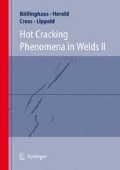Abstract
A study of Ni-base weld metal hot cracking resistance was made comparing results from Modified Varestraint-Transvarestraint Testing (MVT), metallographic evaluation and mechanical testing. Submerged arc weld metals were produced with Alloy 625, Alloy 59 and Alloy C-276 filler wires at two levels of heat input. Welds were subjected to MVT testing, three-point and wrap-around bend testing as well as metallographic inspection of weld cross-sections. All test methods generally ranked the lower heat input welds as more crack resistant than those produced with a higher heat input. However, MVT testing ranked alloy types in a different order than mechanical testing and metallographic evaluation. Alloy 59 type weld metals were judged most crack resistant with MVT testing and C-276 welds were ranked as slightly better than those produced with Alloy 625 wires. Mechanical testing and metallographic evaluation, on the other hand, ranked the Alloy 625 type weld metals as most crack resistant and Alloy C-276 weld metals as least resistant. Discrepancies between results of the different test methods and practical experience can most likely be attributed to a number of factors including metallurgical aspects and test procedures. It is concluded that test methods simulating actual application welding conditions as closely as possible are most likely to accurately predict hot cracking susceptibility of real weldments. An assessment of the hot cracking susceptibility of welding consumables should therefore preferably be based on results from a combination of test methods.
Access this chapter
Tax calculation will be finalised at checkout
Purchases are for personal use only
Preview
Unable to display preview. Download preview PDF.
References
L.-E. Stridh, L. Karlsson, S. Rigdal and N. Thalberg, “New methods in Welding of 9% Nickel Steel for LNG Applications”, Proc. IIW 58th Annual Assembly, International Conference “Benefits of new methods and trends in welding to economy, productivity and quality”, 14–15 July 2005, Prague, pp. 39–53.
L. Karlsson, S. Rigdal L.-E. Stridh and N. Thalberg, “Efficient Welding of 9% Nickel Steel for LNG Applications”, Proc. Stainless Steel World 2005 Conference & Expo, 8–10 Nov 2005, Maastricht, pp. 138–142.
L. Karlsson, S. Rigdal and S.L. Andersson, “Welding of highly alloyed austenitic and duplex stainless steels”, Welding in the World, 1997, 39 (2) pp. 99–110.
Hot cracking phenomena in welds, Editors Th. Böllinghaus and H. Herold, Springer-Verlag Berlin Heidelberg, 2005.
CEN ISO 17641 Part 1–3, Destructive tests on welds in metallic materials – Hot cracking tests for weldments – Arc welding processes.
U. Brill, T. Hoffman and K. Wilken, “Solidification cracking: Super stainless steels and nickel base alloys”, Proc. Materials weldability symposium, Materials week 1990, Detroit, ASM International, 1990, pp. 99–105.
T. Kannengiesser, M. Wolf and H. Schobbert, “Recent developments in nickel base material welding considering the influence of shielding gas on the hot cracking resistance”, IIW Doc. II-1554–05.
M.J. Cieslak, T.J. Headley and A.D. Jr. Romig, “The welding metallurgy of HASTELLOY Alloys C-4, C-22 and C-276”, Met. Trans. A, 1986, 17, pp. 2035–2047.
M.J. Cieslak, “The welding and solidification metallurgy of Alloy 625”, Welding Journal, 1991, 70, pp. 49s–56s.
J.N. DuPont, “Solidification of an Alloy 625 weld overlay”, Metallurgical and Materials Transactions A, 1996, 27A, pp. 3612–3620.
M. Raghavan, B.J. Berkowitz and J.C. Scanlon, “Electron microscopic analysis of heterogeneous precipitates in Hastelloy C-276”, Met. Trans. A, 1982, 13A, pp. 979–984.
U. Heubner and M. Köhler, “Das Zeit-Temperatur-Ausscheidungs- und das Zeit-Temperatur-Sensibilisierungs-Verhalten von hochkorrosionsbeständigen Nickel.Chrom-Molybdän-Legierungen”, Werkstoffe und Korrosion, 1992, 43 (5) pp. 181–190.
Author information
Authors and Affiliations
Editor information
Editors and Affiliations
Rights and permissions
Copyright information
© 2008 Springer-Verlag Berlin Heidelberg
About this chapter
Cite this chapter
Karlsson, L., Bergquist, EL., Rigdal, S., Thalberg, N. (2008). Evaluating Hot Cracking Susceptibility of Ni-Base SAW Consumables for Welding of 9% Ni Steel. In: Böllinghaus, T., Herold, H., Cross, C.E., Lippold, J.C. (eds) Hot Cracking Phenomena in Welds II. Springer, Berlin, Heidelberg. https://doi.org/10.1007/978-3-540-78628-3_17
Download citation
DOI: https://doi.org/10.1007/978-3-540-78628-3_17
Publisher Name: Springer, Berlin, Heidelberg
Print ISBN: 978-3-540-78627-6
Online ISBN: 978-3-540-78628-3
eBook Packages: Chemistry and Materials ScienceChemistry and Material Science (R0)

